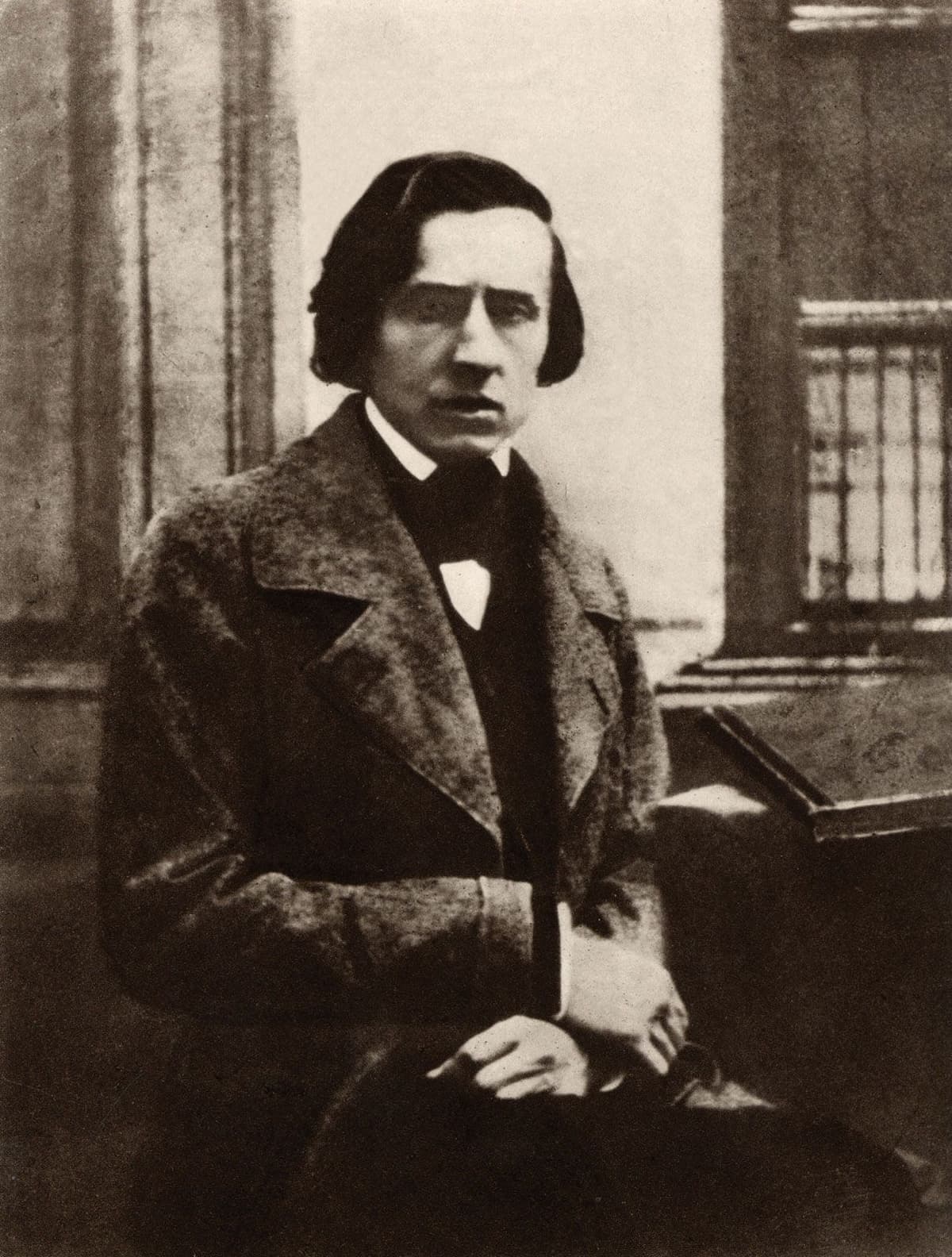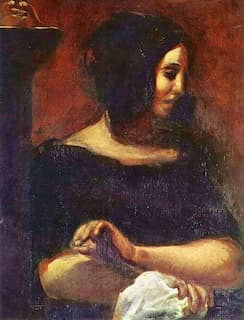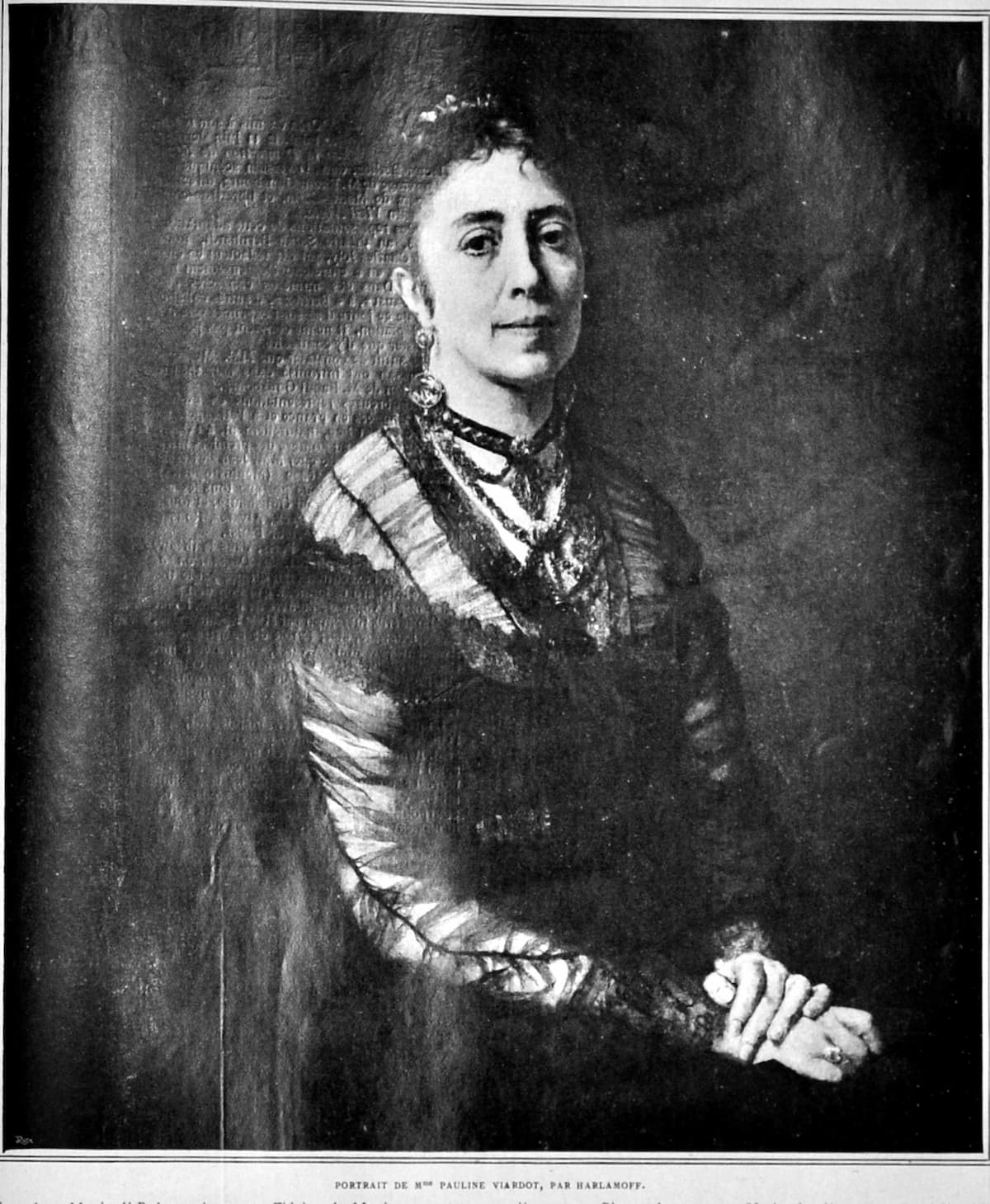Chopin’s Biography for Beginners

Frédéric Chopin
Frédéric Chopin was born in present-day Poland in 1810. He was famous for a few things:
• He wrote a lot of emotional solo piano music at a time when composers proved their seriousness by writing orchestral showpieces or operas. Despite how he ignored this convention, his reputation soared anyway.
• His health was bad throughout his life, and he died young in 1849 of tuberculosis.

Portrait of George Sand by Delacroix
• He had a relationship with a famous author named George Sand. She dressed like a man and flouted gender roles and was one of the best-loved authors in Europe. They never got married, though, and broke up toward the end of his life.
• He cared deeply about his Polish identity. During his life, Polish people were embroiled in an uprising against the Russian empire. He wrote a lot of music with a political, Polish twinge to protest what he felt was the injustice of the Russian occupation.
Sound intriguing? We hope so!
Here’s a selection of works by Chopin to get you started:
Piano Concerto No. 1 – 1830
Yes, we did just say that Chopin was most famous for writing for solo piano and not for orchestra, but that’s one reason why his Piano Concerto No. 1 stands out in his oeuvre.
He gave its premiere in October 1830 in Warsaw. A few weeks later, the November Uprising occurred. Notably, the third part (or “movement”) of the concerto contains rhythms popular in Polish dances, making it clear what side of the conflict Chopin stood. (That starts at 33:47 in the Youtube video above.)
Chopin wrote this piece when he was twenty before his artistic identity was fully formed. Some people have argued that he was inexperienced and didn’t write the orchestra part very well, while others are fond of the choices he made. Goes to show you can’t please everyone, even if you’re one of the most beloved composers of all time!
Nocturne in C-sharp Minor – 1830
This heartbreaking piece has a fascinating history. It was composed as a study for Chopin’s composer sister Ludwika in 1830, right before the November Uprising and Chopin’s departure for France to seek his fortune as a pianist. Ludwika stayed home, while Chopin became an exile of sorts in Paris. He had mixed feelings about this separation for the rest of his life.
The manuscript stayed in the family and wasn’t published until 1870, two decades after Chopin’s death.
Revolutionary Etude – 1831
Chopin’s homesick yearning never really ceased. In 1831 he wrote this piece after realizing that the Polish uprising against the Russians was doomed. According to legend, when he learned of the outcome of the conflict, he cried, “All this has caused me much pain. Who could have foreseen it?” One can hear that pain in this brief, violent piece.
Mazurkas, Op. 17: No. 4 in A Minor – 1833
When he wrote his mazurkas, Chopin combined the instrumentation of the classical tradition with folk tradition. These were stylized folk dances based on the Polish mazur dance, featuring elements like repetition and specific rhythmic patterns. Ultimately, Chopin’s mazurkas ended up becoming a kind of genre unto themselves.
This one sounds deeply lonely and troubled. One can easily imagine Chopin improvising after dark in the candlelight, looking out his Parisian apartment window, longing for Polish freedom, and for the company and safety of his family and friends back in Warsaw.
Fantaisie-Impromptu – 1834
This is another one of Chopin’s pieces that was published posthumously. It lasts for about five minutes and consists of two stormy outer sections that surround a tender, delicate inner section for contrast.
Ballade No. 1 in G-minor – 1835
You might remember this piece from the 2002 Holocaust movie The Pianist.
In 1836, Chopin’s friend and colleague, composer Robert Schumann, wrote about this classic, “I have a new Ballade by Chopin. It seems to me to be the work closest to his genius (though not the most brilliant). I even told him that it is my favourite of all his works. After a long, reflective pause he told me emphatically: ‘I am glad, because I too like it the best, it is my dearest work.’”
This piece is ten minutes long, but it never feels like it. It’s full of drama and heartache.
Here’s a shortened version from the movie:
Raindrop Prelude – 1838
Between the composition of the Ballade in G-minor and the Raindrop Etude, Chopin met George Sand, and the two eventually became lovers.

Portrait of Frédéric Chopin and George Sand by Eugène Delacroix
In 1838 they famously took a trip together to the island of Mallorca, off the coast of Spain. It was supposed to be a romantic getaway, but between suspicious Catholic locals and Chopin’s deteriorating health, it turned into quite the nightmare. Bad, rainy weather was the last straw. Supposedly this prelude reflects the rhythm of raindrops Chopin heard during that trip.
Piano Sonata No. 2 – 1837-1839
Chopin’s famous funeral march – the theme of which has become the cultural shorthand for death – was actually one portion of a four-movement work for solo piano, his Piano Sonata No. 2 in B-flat Minor. (That specific part starts at 14:35.)
When it was premiered, other composers were skeptical about this sonata, feeling it lacked cohesion. Present-day audiences, however, adore it. Take a listen for yourself and see what you think of it. If you don’t like it, that’s fine! Amusingly, composer Felix Mendelssohn once said outright about this sonata, “Oh, I abhor it.”
Heroic Polonaise – 1842
One of the reasons that Chopin loved George Sand was that she understood his deep and complicated feelings about his first love, Poland. She was very dialed into revolutionary politics, and even began her own revolutionary newspaper.
In 1842 Chopin composed a piece that came to be known as the Heroic Polonaise. And you’ll never guess what country the polonaise is from!
Just like he’d done with the mazurka, Chopin took elements of this Polish dance and turned it into a concert piece for piano.
Sand was dazzled. She wrote to him, “The inspiration! The force! The vigour! There is no doubt that such a spirit must be present in the French Revolution. From now on this polonaise should be a symbol, a heroic symbol.”
Berceuse in D-Flat Major – 1843
Chopin began writing this lullaby when staying at George Sand’s country estate in the summer of 1843.
Historians have theorized that it might have been inspired by the presence of a little girl named Louisette, who was the daughter of family friend Pauline Viardot, since Chopin and Sand were helping watch her that summer while Viardot went on a concert tour.

Pauline Viardot in 1910
The first thing to listen to in this piece is how the lower notes are repeated over and over again. Chopin composes all kinds of shimmery notes in the top hand to keep it from ever feeling repetitive. It’s fascinating to see what his mind came up with to hold our attention.
Barcarolle in F-sharp Major – 1846
There’s no big political message in this one, like there is in so many of Chopin’s other works. It’s just an incredible piece of piano music. Here’s one video explaining why.
That’s a lot of information to take in! For your first time listening, try concentrating on the rhythm. This piece is in a time signature known as 6/8, which creates a rocking effect. A barcarolle is a kind of boat song that originated with Venetian gondoliers. It’s deeply romantic: one can almost see the water rippling in the canal as the gondolier draws his row through it.
This is one of Chopin’s last major compositions, another reason why it deserved a place on this list.
Minute Waltz – 1847
To wrap up our survey, here’s one of Chopin’s most famous little piano pieces. There’s a legend that Chopin’s Minute Waltz was meant to be played in under sixty seconds, hence the name; but actually, the name means “minute” as in “small,” not “minute” as in the unit of time.
In French, this piece is known as “valse du petit chien”, or “waltz of the puppy.” Chopin adored George Sand’s dog Marquis, and apparently Marquis enjoyed chasing his own tail. This piece might be Chopin’s musical tribute to Marquis and his antics. It’s theorized that the repeated, slightly discordant A-flat notes in the waltz might be a representation of the bell on the little dog’s collar tinkling. It’s an appealing, adorable thought.
Conclusion
So there you have it, twelve works that serve as an introduction for beginners to Chopin’s life and work. Once you listen to these works, you’ll have a pretty good idea if you want to keep getting to know his music.
If you do, make our Chopin tag your next stop.
Happy listening!
For more of the best in classical music, sign up for our E-Newsletter

